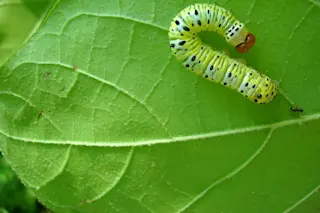An Azteca ant approaches a caterpillar on a laurel leaf in Jalisco, Mexico. After making such a find, it will recruit nestmates to the leaf to bite the caterpillar's underside until it drops off the leaf. Credit: Elizabeth G. Pringle. Partnerships between ants and trees are classic examples of mutualism in nature---the trees provide room and board for the ant colonies who protect the trees from pests. This seems like a pretty good deal, and two studies published this week show that some of these partnerships can vary with environmental conditions and others may even be irresistible---literally.
Leaf Insurance
The first symbiosis takes place in Mexico and Central America, where Azteca ants nest in the stem cavities of laurel trees. Laurel trees are especially vulnerable to leaf-eating pests during dry spells, so the tree has evolved a cooperative solution: bodyguard ants. Comparing ant colonies across 26 sites with varying amounts of rain, researchers found that when trees are low on water, they perhaps counterintuitively boost their sugar production. This investment has a hidden benefit: more sugars support larger colonies of ants. That means more ant bodyguards available to defend leaves against pests. When a caterpillar finds its way onto a laurel leaf, the ants will swarm and nibble the wiggly critter until it lets go of the leaf and falls off, according to the study published in PLOS Biology yesterday.
Addicted to Sugar
Another species of Central American tree, the Acacia, has an even more foolproof plan. The results of this study, published in Ecology Letters, describe how the tree makes its sugars irresistible to Pseudomyrmex ants by lacing them with an enzyme to make the ants unable to digest other kinds of sugar. This way the ants are completely and exclusively dependent on the Acacia sugars, guaranteeing that they'll stick around to protect the tree at all costs. Ed Yong at Not Exactly Rocket Science describes:
One sip, and the insects are consigned to a life of indentured servitude. ... [One researcher] compares the tree to a dairy company that sells lactose-free milk that has been chemically altered to render its customers unable to digest normal milk. Any customer who drank it would be forced to stick to that one lactose-free brand.
A slick move for a species that's immobile.














